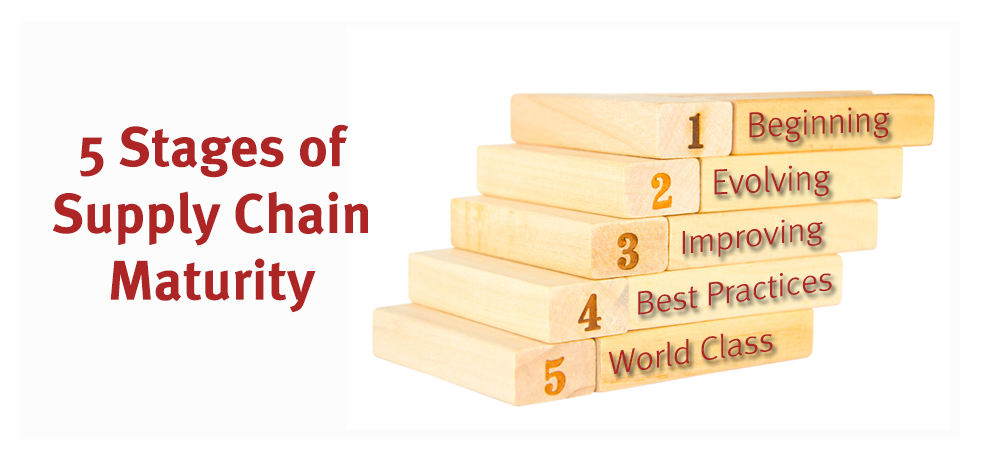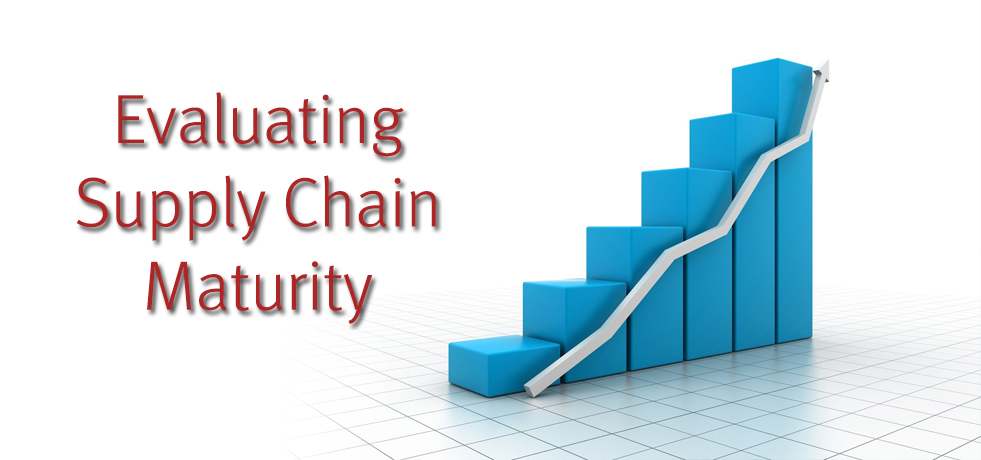Have you ever heard of a supply chain maturity model? If not, you might be missing out on a valuable tool to identify areas for improvement… And that means you might be missing out on significant cost or other performance benefits.
There are a number of supply chain maturity models in circulation, but they all follow the same key principles.
By sitting down with your team and completing a fairly simple supply chain maturity matrix (in MS Excel or a similar tool) and taking some time to analyse the results (perhaps with the help of a supply chain consulting firm), you can develop a picture of how far your supply chain has advanced compared with industry averages, and easily spot the areas where improvement will yield beneficial outcomes.
The Five Stages of Supply Chain Maturity

A supply chain maturity model, such as the maturity matrix provided by our colleagues at Logistics Bureau, can—and indeed should—be used to measure various elements of supply chain performance.
It would require a much longer post than this to describe the nature of each stage of maturity for each of the usual measured dimensions. As a guide though, the general stages of supply chain maturity might be described in the following way.
Stage 1 – Beginning: Companies at stage 1 on the maturity scale are often new businesses or much larger organisations that haven’t focused much on supply chain strategy.
While there may be some awareness of the need to integrate the supply chain, there is little evidence of efforts to achieve synergies between supply chain partners or even internal functions. Most aspects of supply chain performance are managed reactively.
Stage 2 – Evolving: If your company is at the evolving stage of maturity, you can see evidence of internal supply chain integration.
At stage 2, the focus is still largely internal, although there’s typically some visibility of the external environment. Some integration of internal functions exists, with performance objectives being somewhat aligned, at least when compared with companies at stage 1 on the maturity scale.
Stage 3 – Improving: By the time a company reaches stage 3, evidence exists of a much wider awareness of strategic supply chain importance.
Functional teams are much more cognizant of their place within the supply chain operation and the cross-functional ramifications of their decisions and actions. Integration exists within the supply chain, with functions being identified according to their place in the “plan, make, source, and deliver” sequence.
Stage 4 – Best Practices: Stage 4 represents companies that have spent considerable time, investment, and energy into developing a high-performance supply chain. Best practices are clearly in evidence and supply chain integration will have been achieved internally and to some extent, externally.
Stage 5 – World Class: This is the ultimate level of supply chain maturity. If your company is at stage 5 of the maturity matrix, it will be known around the world as one of the leading global supply chains. Obviously there are few organisations at this level and in fact, the majority of companies have not yet attained stage 3.
What Does a Maturity Model Measure… And How?
A general supply chain maturity model (or matrix) will cover a number of supply chain performance dimensions. The Logistics Bureau matrix for example, covers the following areas:
- Demand forecasting
- Customer interaction
- Supplier relationships
- General supply chain management
- Culture
- Process integration
- Technology
- Business and supply chain strategy
- Supply chain network and organisational structure
Each dimension—perhaps presented via a spreadsheet tab or as a section of a questionnaire—is populated with a number of statements relating to a certain aspect of that area’s operation. Participants in the modeling process go through the statements and highlight the one which most closely matches the state of operation in their supply chain.
At the end of the modeling exercise, the highlighted statements are assessed to establish the maturity of each area and of the supply chain overall.
How to Derive Value from the Supply Chain Maturity Matrix
It can be useful to understand the overall maturity of your supply chain capabilities, but realising the real value of supply chain maturity modeling begins by homing in on performance in each dimension.
As a general rule of thumb, any dimension in which your company is not at maturity stage 3 should present cause for concern. In the Logistics Bureau tool, stage 3 is indicated by a score of 55% to 60%.
Better still, the supply chain maturity matrix also shows you which specific aspects of each supply chain dimension require attention.
It’s Easy to Identify Improvement Opportunities
As an example, let’s assume that your company achieves a score lower than 50% in the area of process integration. However, on closer examination, you can see that you scored above average on a number of the sub-elements for the process integration dimension.
The overall score was actually dragged down because of a really poor score in a couple of specific sub-elements, those being the involvement of business management in IT design, and cross-functional alignment of key performance indicators (KPIs).
Now instead of getting in a flap about process integration generally, you can see that you might have two or three specific issues to address.
You might need to implement a project to improve the cross-functional relevance of supply chain KPIs, and also work with managers in business and IT functions to promote meaningful collaboration in future technology projects.
You may also have some issues to address with existing IT solutions as well, but otherwise, you’re in good shape from an integration perspective. Furthermore, by addressing the issues identified from this relatively simple assessment process, you’ll be making a step-change toward a more mature, and more competitive supply chain.
Check Your Supply Chain Maturity for Free!
Hopefully by now you have an idea of the value to be had from maturity modeling, and are perhaps wondering just how big a project would be required to carry it out.
Well, here’s the best news of all, because our colleagues at Logistics Bureau are giving you the opportunity to evaluate your supply chain maturity free of charge. All you have to do is head over to the Logistics Bureau website, where you can access an online portal to the supply chain maturity matrix.
You’ll need to get together with some of your managers responsible for supply chain activity, just so you can get a consensus on your responses to the survey-style questionnaire.
Other than that though, there are no costs to worry about and your maturity score will be presented at the end of the online process. You’ll also receive a copy by email, along with an invitation to discuss your results on the phone with Logistics Bureau’s owner and Managing Director, Rob O’Byrne.
Does that sound like a rare and valuable opportunity? If so, why not get your team together, sign into the matrix and take advantage while it lasts.

